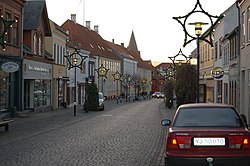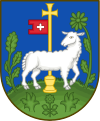Assens, Denmark
| Assens | |||
|---|---|---|---|
| Town | |||
 |
|||
|
|||
| Coordinates: 55°16′N 9°54′E / 55.267°N 9.900°ECoordinates: 55°16′N 9°54′E / 55.267°N 9.900°E | |||
| Country | Denmark | ||
| Region | Southern Denmark (Syddanmark) | ||
| Municipality | Assens | ||
| Population (2014) | |||
| • Total | 5,956 | ||
Assens (Danish pronunciation: [ˈʔasn̩s]) is a town with a population of 5,956 (1 January 2014)) on the west coast of the island of Funen on the eastern side of the Little Belt in central Denmark. By road, Assens is located 41.2 kilometres (25.6 mi) southwest of Odense, 34 kilometres (21 mi) northwest of Faaborg, and 33.34 kilometres (20.72 mi) southeast of Middelfart. Assens is the municipal seat of Assens Municipality in Region of Southern Denmark. It was the birthplace of sculptor Jens Adolf Jerichau who married the well-known portraitest Elisabeth Jerichau-Baumann; both artists' works are exhibited at the local art museum, Vestfyns Kunstmuseum. It is also the birthplace of Denmark football internationals, goalkeeper Thomas Sørensen and striker John Eriksen.
Assens is located on the site of an old ferry landing linking Funen and the south of Jutland. A bay provided a natural harbour while the Little Belt encouraged trade and transport. It probably became a market town in the 13th century. The ferry, which probably originated in the Middle Ages, became particularly significant in the 16th century with sizeable cattle exports. The town was hard hit by the Swedish Wars in the 17th century, causing a reduction in trade. It nevertheless continued to be the main ferry link between Jutland and Funen.
Prosperity returned at the end of the 18th century, increasing in the 19th century after a new harbour was completed in 1822. However the railway to Middelfart in 1865 provided considerable competition but the town suffered above all from the discontinuation of the ferry service after Southern Jutland was lost to the Germans in 1864.
...
Wikipedia



